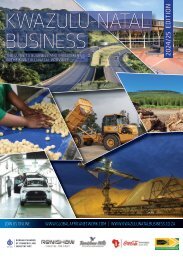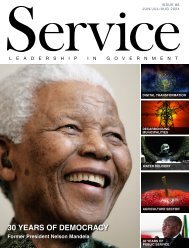Limpopo Business 2016-17 edition
The 2016/17 edition of Limpopo Business is the eighth issue of this highly successful publication that, since its launch in 2007, has established itself as the premier business and investment guide to the Limpopo province. Limpopo is unique in terms of its abundant natural and human resources, and is also one of the key drivers behind the South African economy. This edition of Limpopo Business is officially endorsed by the Office of the Premier of Limpopo.
The 2016/17 edition of Limpopo Business is the eighth issue of this highly successful publication that, since its launch in 2007, has established itself as the premier business and investment guide to the Limpopo province.
Limpopo is unique in terms of its abundant natural and human resources, and is also one of the key drivers behind the South African economy.
This edition of Limpopo Business is officially endorsed by the Office of the Premier of Limpopo.
Create successful ePaper yourself
Turn your PDF publications into a flip-book with our unique Google optimized e-Paper software.
OVERVIEW<br />
with branch networks, the percentage<br />
of South Africans so<br />
served grew from 50% to 80%.<br />
In the “banked” category (more<br />
traditional but including new devices),<br />
the percentage grew from<br />
46% to 75%.<br />
With cellphone access in that<br />
time having grown from 42% to<br />
90%, one would expect that to<br />
have been the main reason for<br />
this growth, but that is not the<br />
case. James Francis, writing for<br />
Brainstorm, points out that of<br />
the nine-million South Africans<br />
who use mobile money, only 3%<br />
fall in the LSM 1-4 category (ie,<br />
poorer members of the population).<br />
He writes that “mobile<br />
money in South Africa has been<br />
catastrophic”. However, the South<br />
African banking sector’s excellent<br />
infrastructure (plus the efforts of<br />
the Big Four and Capitec to reach<br />
out to new markets) has made up<br />
for this failure.<br />
Banks and cellphone companies<br />
continue to believe that<br />
they need one another. Vodacom<br />
and Bidvest are working on the<br />
mobile money M-Pesa scheme,<br />
Standard Bank and MTN collaborate<br />
on mobile banking and<br />
there have been recent moves<br />
linking Old Mutual and Telkom,<br />
and Sanlam and African Bank.<br />
(The “good” African Bank that is,<br />
with the bank having been split<br />
up into two entities after taking<br />
on too much unsecured debt).<br />
Sifiso Skenjana has noted in the<br />
Sunday Times that African Bank<br />
still has 400 branches and 150 000<br />
people per month going through<br />
these branches, so this represents<br />
a huge potential market for a<br />
financial services company.<br />
Telkom is apparently hoping that its link-up with Old Mutual will prove<br />
attractive to customers wanting funeral insurance.<br />
Skenjana also points out that South Africa has a ‘stokvel’ (savings club)<br />
market valued at R44-billion, and Sanlam recently launched new products<br />
aimed at tapping into that market.<br />
Among other recent innovations designed to reach the unbanked<br />
were Teba Bank’s initiative that allows customers to deposit money at<br />
supermarkets, Pick n Pay Go Banking (a division of Nedbank), the fact that<br />
70% of Absa’s new ATMs (400 in one year) were visited in poorer areas and<br />
the launch of two mobile banks, FNB also created mobile branches and<br />
most of Standard Bank’s new sites were planned for townships (Finscope).<br />
Absa’s partnership with Thumbzup allows shops to accept card payments<br />
with smartphones and tablets. Introduced in 2012, the device<br />
turns phones into terminals. In the same year, Absa took over Edcon’s<br />
card portfolio, massively increasing the bank’s reach (Edcon brands<br />
include Edgars, CNA and Jet).<br />
Absa’s Entry Level and Inclusive Banking (Elib) branches have proved<br />
popular, accounting for an increasingly high percentage of the bank’s<br />
loans, despite still representing quite a small number of actual branches.<br />
Nedbank has Approve-it, which allows customers to accept or<br />
reject an Internet transaction by cellphone.<br />
FNB has a wide range of cellphone-banking options and a Facebook<br />
application whereby cellphone vouchers can be posted on the socialnetworking<br />
site. The eWallet application converts the voucher into<br />
cash or airtime.<br />
Standard Bank’s community-banking initiative offers a low-cost<br />
cellphone-banking service. Retailers can act as agents for the bank,<br />
even in remote rural areas. Shops such as Shoprite, Pep and Spar are<br />
connected, as are certain spazas.<br />
Ubank is owned by a trust that is managed by the Chamber of<br />
Mines and the National Union of Mineworkers (NUM). It has about 100<br />
branches and an important presence in <strong>Limpopo</strong> because of its strong<br />
focus on the mining sector. Ubank has about half-a-million clients.<br />
ONLINE RESOURCES<br />
Banking Association South Africa: www.banking.org.za<br />
Financial Services Board: www.fsb.co.za<br />
Institute of Bankers in South Africa: www.iob.co.za<br />
National Credit Regulator: www.ncr.org.za<br />
Office of the Auditor-General of South Africa: www.agsa.co.za<br />
Ombudsman for Banking Services: www.obssa.co.za<br />
Public Investment Corporation: www.pic.gov.za<br />
81 LIMPOPO BUSINESS <strong>2016</strong>/<strong>17</strong>


















